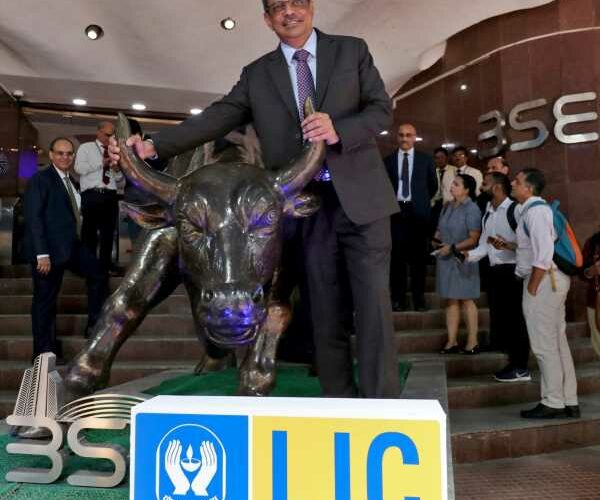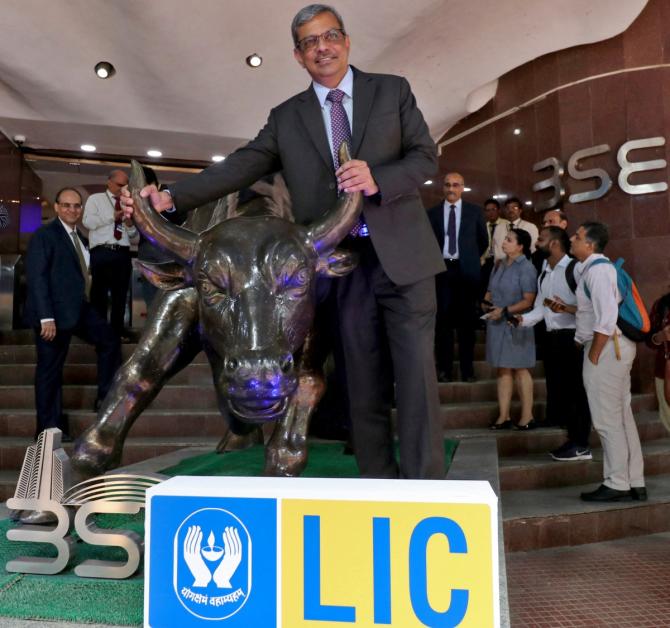‘LIC’s investment decisions won’t change’
‘We try to pick up stocks early and hold onto them for the long term.’
‘We are not someone who buys and sells on a daily basis.’
Life Insurance Corporation of India hit the market with its IPO in May.
Since then, the value of the insurance behemoth’s shares has eroded significantly.
“We are here for the stakeholders and whatever we have done in the past for the policyholders, we will now be doing for the shareholders as well,” LIC Chairperson Mangalam Ramasubramanian Kumar tells Subrata Panda/Business Standard.
What explains the erosion in LIC’s share prices?
The markets have been very volatile for some time now.
We are not very sure whether that has got factored into the share price.
We firmly believe that once the market stabilises our inherent strength and performance will get recognised and the share price will move up.
The float may appear small, but there is enough in terms of volume and once the delivery occurs on a regular basis, I think it will improve.
Looking at the stock’s performance, would you say the IPO was rushed?
We were in the middle of roadshows when the war [in Europe] started, and at that time we did pause for a moment.
But then we saw a window of opportunity and launched the public issue.
Had we delayed it, we would have had no visibility as to when the next window would arrive.
Markets, both globally and locally, had become very tough.
We decided to launch the issue and I am really thankful to the policyholders and employees, who stepped up to contribute.
Do you think the investment bankers did a fair job in terms of pricing the issue appropriately and marketing the IPO?
They did a very good job. The pressure of the markets and the situation was there on everyone, including them.
The government was very decisive in terms of taking decisions based on the inputs provided by the investment bankers.
In fact, they had a lot of feedback from the investors and I would like to compliment them for getting the deal through.
Post initial public offering, the state of the markets can test the patience of investors. So, it’s a question of time.
Your retail APE (annual premium equivalent) and total APE market share is around 40 per cent. Is it possible for LIC to regain some market share from private players?
Between March 2020 and 2022, there were a lot of Covid-related disruptions, but we still managed to sell over 20 million policies.
Our overall market share rose from 61 per cent to 65 per cent in a four-month period.
On the APE basis, I am sure we have been able to regain some market share.
LIC is a very large institution and we have come out of every tough situation stronger.
In fact, the post-Covid recovery is a sign of our resilience and I hope the current rise in Covid cases does not disrupt the way the first two waves did.
We are very confident that we will be able to retain the market share of 60-65 per cent, if not regain lost market share from private peers.
Brokerage houses have questioned your ability to sell and market non-par (non-participatory) products because you do not have bancassurance tie-ups with large banks. Is there a plan to tap them to be your banca partner?
Depending on the flavour of the market and customers’ needs, we were selling more par products.
It was a segment that customers were more comfortable with because they tried to get more bonuses.
We were the first to introduce unit-linked insurance products (ULIPs) in the Indian market.
But depending on the demand, we have been rotating our products and bringing in new ones whenever required.
On the bancassurance side, we have around 62,000 outlets.
We have to reinforce our focus on this channel. We have met with bankers recently.
Besides, for the first time we have launched a product exclusively for this channel.
So, there will be some differentiated products for the bancassurance channel in the coming days. And, with the focus on ULIPs, and protection products, I believe, we will be able to score over the competition in terms of non-par business.
Last year, we tied up with some banks.
We are still working on a few more tie-ups.
Now that each bank can have tie-ups with three insurance companies, there are several that do not have more than two tie-ups and we are looking to tap such banks.
What share of your total business do you think will come from the bancassurance channel once you scale it up?
At present, it is around 3-3.5 per cent.
In a couple of years’ time, we would like to raise it to at least 8-10 per cent, if not more.
It will depend on how many banks we can reach out to and how much training we can provide bank employees in terms of the products we are launching.
We have 14 major banks, including IDBI Bank, 13 regional rural banks, and 45 cooperative banks.
Also, we have 71 corporate agents, 35 insurance marketing agents, and 63 brokers.
In all, we have around 62,000 outlets and tapping into them is going to take time. But we are working on some of the big outlets initially in the tier-I, II, and III areas.
The second step will be to launch differentiated products for this channel. And, in five years, we would like to be the number one player in the bancassurance channel.
We would like this channel to contribute at least 15 per cent to our business by then.
What will the share of the non-par business be in your portfolio?
On an APE basis, non-par is about 7 per cent now.
We would like to raise that to 12-15 per cent in three-four years.
Your margins were around 9 per cent in September 2021 and some of the private players have margins upwards of 25 per cent. How soon do you think the change in product mix will have a positive impact on the margins? What is your target as far as margins are concerned?
If you look at private insurance companies when they got listed, they too had value of new business margins around the same levels and it has taken some time for them to scale it to over 20 per cent.
I think we would like to reach margins of 12-15 per cent in a couple of years, and five years down the line, we should be able to have margins of 20 per cent.
Commentators have said the jump in LIC’s EV [embedded value] is mainly due to the bifurcation of funds and the equity gains from the stock market. Is that a fair assessment?
Going forward, how will the EV of the corporation grow?
EV is based on many factors. It is not just the way the funds are bifurcated, how much is in equity or debt.
It is very difficult to say unless we do the assessment as of now.
As we speak, the EV calculation is under process and we will bring it out before June 30.
Once the EV is out, I think it will give a fair idea to everyone on how things will progress, going forward.
How has the response been for IDBI Bank’s roadshows? Is there a consensus with the government on how much LIC can hold in IDBI Bank?
The roadshows were very successful.
IDBI Bank has come out of the PCA (prompt corrective action) framework. But markets being what they are amid geopolitical tensions, we don’t know how things will pan out.
Like I have said in the past, LIC would like to continue to hold a good stake in IDBI Bank because in a very short span it has done very well in bancassurance for us, and it has a lot of ambitious programmes lined up for this business.
That being the case, we will be talking to the government to ensure that we continue to have some stake.
Of course, divestment of government stake is for the government to speak about.
Does LIC still have the ambition of owning a bank?
LIC did have this kind of ambition twenty 20 years back.
In those days, we had more than 30 per cent stake in Corporation Bank. And we had a good amount of stake in other banks as well.
Once the regulations changed, we had to bring down our stake.
We also did apply for a banking licence through LIC Housing Finance but it did not materialise.
Having said that, in case we do not have a bank, at least allowing us sufficient stake in banks can certainly help us do more bancassurance business and there could be a lot of synergies around housing loans.
People were expecting better dividends and felt disappointed with the amount of dividend that was announced. Given the policyholders have lost some money because of the depreciation in share price, is there a plan to sweeten the deal for them in some way?
The dividend payout that was announced was a board decision. But, going forward, we will definitely keep the aspirations of our shareholders in mind.
It will depend on the outcome of the performance, surplus generation, and value creation.
We are here for the stakeholders and whatever we have done in the past for the policyholders, we will now be doing for the shareholders as well.
How will your investment decisions change now that LIC is listed?
Investment decisions will not change because they have always been guided by sound principles.
We have an investment committee and we are very contrarian.
We buy when the market is down and sell when it’s up and that’s how we booked a good amount of profit last year.
But then this is a question that is often repeated: Why do we have investments in certain companies? We take a call depending on the company’s performance and their forward guidance.
We try to pick up stocks early and hold onto them for the long term. We are not someone who buys and sells on a daily basis.
Would you step up lateral hiring in areas where you feel organic talent is lacking?
We have already hired a CFO, head of investor relations from the market.
We are looking out for a chief digital officer and a technology officer.
We have already advertised some of these positions.
How would you reflect back on your term as chairperson?
It has been a rollercoaster ride. I joined in March 2019, and by the time I settled in, the COVID-19 outbreak happened.
The announcement of the IPO also came around the same time.
I will be looking back with a lot of satisfaction at what we aspired to do and achieved.
Feature Presentation: Rajesh Alva/Rediff.com
Source: Read Full Article



